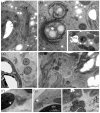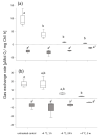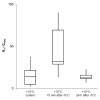Fusion of Mitochondria to 3-D Networks, Autophagy and Increased Organelle Contacts are Important Subcellular Hallmarks during Cold Stress in Plants
- PMID: 33228190
- PMCID: PMC7699614
- DOI: 10.3390/ijms21228753
Fusion of Mitochondria to 3-D Networks, Autophagy and Increased Organelle Contacts are Important Subcellular Hallmarks during Cold Stress in Plants
Abstract
Low temperature stress has a severe impact on the distribution, physiology, and survival of plants in their natural habitats. While numerous studies have focused on the physiological and molecular adjustments to low temperatures, this study provides evidence that cold induced physiological responses coincide with distinct ultrastructural alterations. Three plants from different evolutionary levels and habitats were investigated: The freshwater alga Micrasterias denticulata, the aquatic plant Lemna sp., and the nival plant Ranunculus glacialis. Ultrastructural alterations during low temperature stress were determined by the employment of 2-D transmission electron microscopy and 3-D reconstructions from focused ion beam-scanning electron microscopic series. With decreasing temperatures, increasing numbers of organelle contacts and particularly the fusion of mitochondria to 3-dimensional networks were observed. We assume that the increase or at least maintenance of respiration during low temperature stress is likely to be based on these mitochondrial interconnections. Moreover, it is shown that autophagy and degeneration processes accompany freezing stress in Lemna and R. glacialis. This might be an essential mechanism to recycle damaged cytoplasmic constituents to maintain the cellular metabolism during freezing stress.
Keywords: FIB-SEM; Lemna sp.; Micrasterias denticulata; Ranunculus glacialis; TEM; electron microscopy; freezing stress; organelle networks; ultrastructure.
Conflict of interest statement
The authors declare no conflict of interest.
Figures








Similar articles
-
Structural stress responses and degradation of dictyosomes in algae analysed by TEM and FIB-SEM tomography.J Microsc. 2016 Aug;263(2):129-41. doi: 10.1111/jmi.12369. Epub 2015 Dec 28. J Microsc. 2016. PMID: 26708415
-
A new technical approach for preparing frozen biological samples for electron microscopy.Plant Methods. 2020 Apr 7;16:48. doi: 10.1186/s13007-020-00586-5. eCollection 2020. Plant Methods. 2020. PMID: 32280364 Free PMC article.
-
A freshwater green alga under cadmium stress: ameliorating calcium effects on ultrastructure and photosynthesis in the unicellular model Micrasterias.J Plant Physiol. 2012 Oct 15;169(15):1489-500. doi: 10.1016/j.jplph.2012.06.002. Epub 2012 Jul 2. J Plant Physiol. 2012. PMID: 22762790
-
Review: Morphology, behaviour and interactions of organelles.Plant Sci. 2020 Dec;301:110662. doi: 10.1016/j.plantsci.2020.110662. Epub 2020 Sep 7. Plant Sci. 2020. PMID: 33218631 Review.
-
Micrasterias as a Model System in Plant Cell Biology.Front Plant Sci. 2016 Jul 12;7:999. doi: 10.3389/fpls.2016.00999. eCollection 2016. Front Plant Sci. 2016. PMID: 27462330 Free PMC article. Review.
Cited by
-
Temperature- and light stress adaptations in Zygnematophyceae: The challenges of a semi-terrestrial lifestyle.Front Plant Sci. 2022 Jul 19;13:945394. doi: 10.3389/fpls.2022.945394. eCollection 2022. Front Plant Sci. 2022. PMID: 35928713 Free PMC article. Review.
-
A tool for live-cell confocal imaging of temperature-dependent organelle dynamics.Microscopy (Oxf). 2024 Jul 30;73(4):343-348. doi: 10.1093/jmicro/dfad064. Microscopy (Oxf). 2024. PMID: 38217102 Free PMC article.
-
Winter survival of the unicellular green alga Micrasterias denticulata: insights from field monitoring and simulation experiments.Protoplasma. 2021 Nov;258(6):1335-1346. doi: 10.1007/s00709-021-01682-6. Epub 2021 Jul 24. Protoplasma. 2021. PMID: 34304308 Free PMC article.
-
Informing the Cannabis Conjecture: From Life's Beginnings to Mitochondria, Membranes and the Electrome-A Review.Int J Mol Sci. 2023 Aug 22;24(17):13070. doi: 10.3390/ijms241713070. Int J Mol Sci. 2023. PMID: 37685877 Free PMC article. Review.
-
The cell biology of charophytes: Exploring the past and models for the future.Plant Physiol. 2022 Oct 27;190(3):1588-1608. doi: 10.1093/plphys/kiac390. Plant Physiol. 2022. PMID: 35993883 Free PMC article.
References
-
- Guy C.L. Cold-Acclimation and Freezing Stress Tolerance - Role of Protein-Metabolism. Annu Rev. Plant Phys. 1990;41:187–223. doi: 10.1146/annurev.pp.41.060190.001155. - DOI
-
- Song Y., Liu L., Feng Y., Wei Y., Yue X., He W., Zhang H., An L. Chilling- and Freezing- Induced Alterations in Cytosine Methylation and Its Association with the Cold Tolerance of an Alpine Subnival Plant, Chorispora bungeana. PLoS One. 2015;10:e0135485. doi: 10.1371/journal.pone.0135485. - DOI - PMC - PubMed
-
- Stamenković M., Woelken E., Hanelt D. Ultrastructure of Cosmarium Strains (Zygnematophyceae, Streptophyta) Collected from Various Geographic Locations Shows Species-Specific Differences both at Optimal and Stress Temperatures. Protoplasma. 2014;251:1491–1509. doi: 10.1007/s00709-014-0652-x. - DOI - PubMed
MeSH terms
Grants and funding
LinkOut - more resources
Full Text Sources

